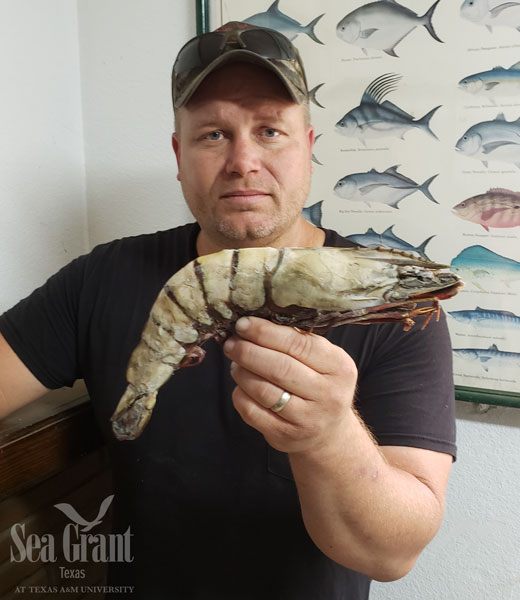Finding Bigger Shrimp to Fry: Massive Asian Tiger Shrimp Caught
This Asian tiger shrimp was caught in the Gulf of Mexico and measures at over a foot long!
May 13, 2019

From the legendary kraken to Homer’s Scylla, what lies beneath the surface of the ocean has long fascinated humanity. But finding a great beast is not simply the stuff of folklore. While trawling for white shrimp, Brownsville shrimp boat captain Seth Sanders found something of mythological proportions.
In mid-March, about three and a half fathoms off the Louisiana coast, west of the Atchafalaya channel, Sanders found the largest Asian tiger shrimp he had ever seen. Tiger shrimp are the largest members of the Penaeidae family, but this particular shrimp measured 12.5 inches long. The species has been known to reach around 13 inches, but it is a rare find.

Sanders said, “When I caught this shrimp, I knew I had to show Texas Sea Grant!”
The Asian tiger shrimp is an invasive species that first arrived in the Western Atlantic and then spread to the Southeast U.S. coast, Gulf of Mexico and Caribbean. However, experts are not sure exactly how the species were introduced, and agencies like National Oceanic and Atmospheric Administration and the U.S. Geological Survey are investigating its origins.
Asian tiger shrimp were once the most popular aquaculture species worldwide, recently surpassed by the whitelegged shrimp, but the species is not farmed in the United States.
“We were worried the population would displace our natives in the same scientific family Penaeidae, and so far it has not happened,” said Tony Reisinger, extension agent at Texas Sea Grant. “We are slowly seeing a few more as extremely small bycatch in our Texas fleets fishing off Texas and Louisiana.”
Although Asian tiger shrimp have not displaced native shrimp populations, the full extent of the effects of this non-native species are unknown. Invasive species, such as Asian carp and lionfish, have captured public attention because of their ability to proliferate and affect their new environments.
One method of controlling invasive species, such as the Asian tiger shrimp is to eat them. “Seth has eaten quite a few Asian tiger shrimp and says they are delicious,” Reisinger said. “We've peeled and split them open, stuffed them with jalapeño and cream cheese, and then wrapped them in bacon for grilling.”
For shrimp and other seafood recipes, check out Texas Sea Grant’s Hooked on Seafood Cookbook.
For more information contact:
Tony Reisinger, Texas Sea Grant Coastal and Marine Resources Agent, Cameron County
Cell: 956-493-8129
Tony.Reisinger@ag.tamu.edu
By Sara Carney '13

